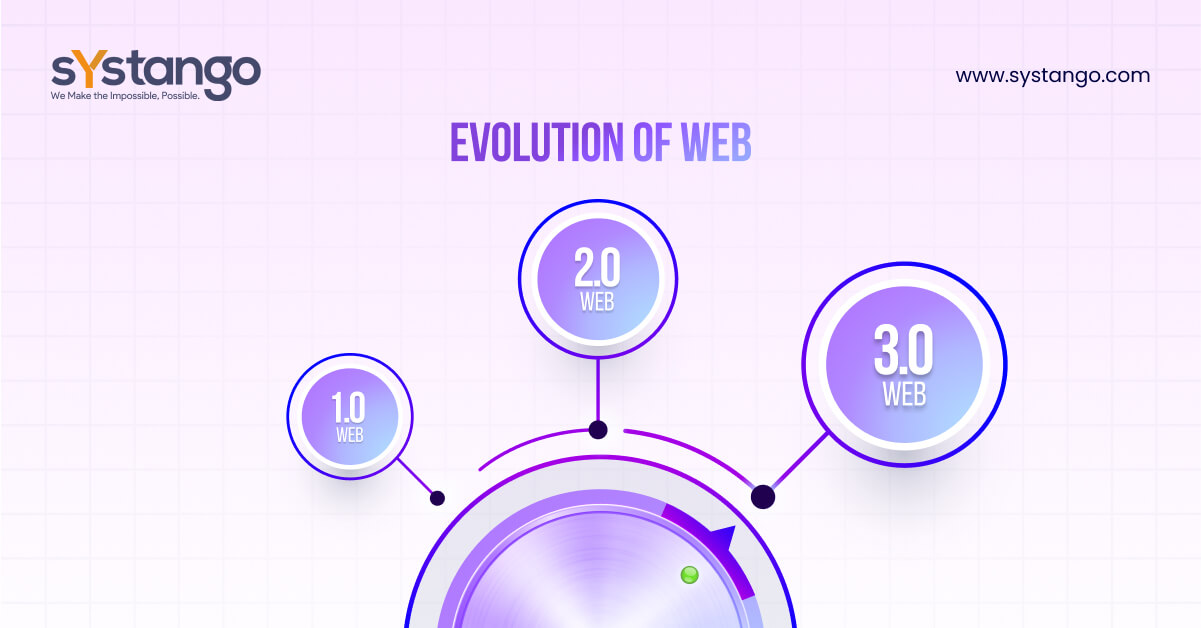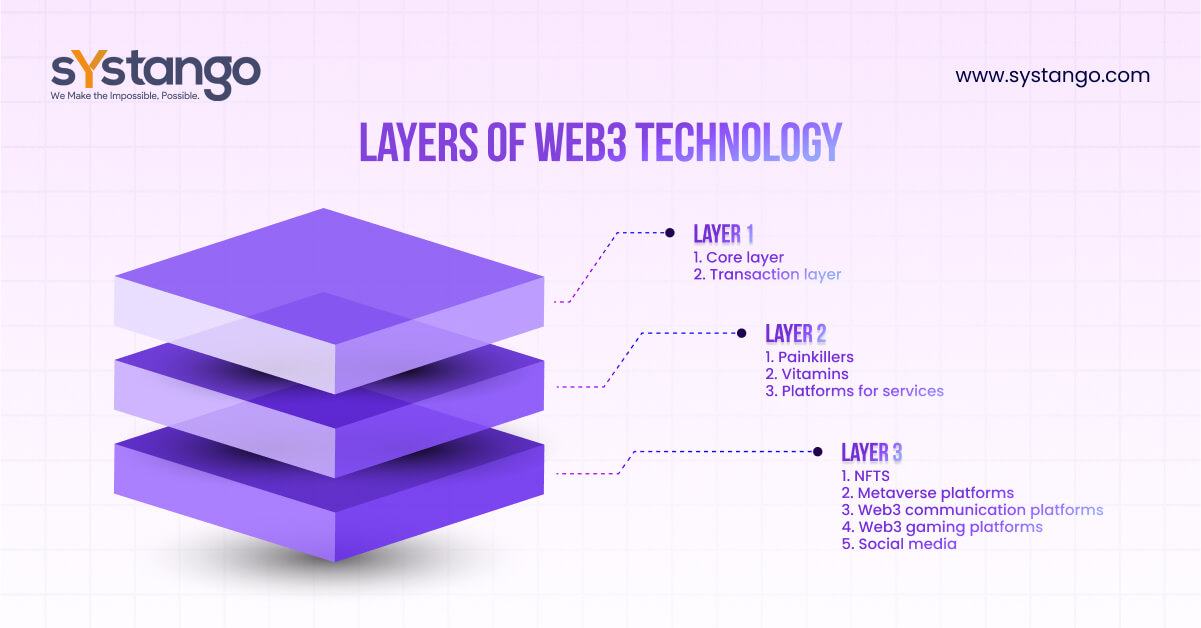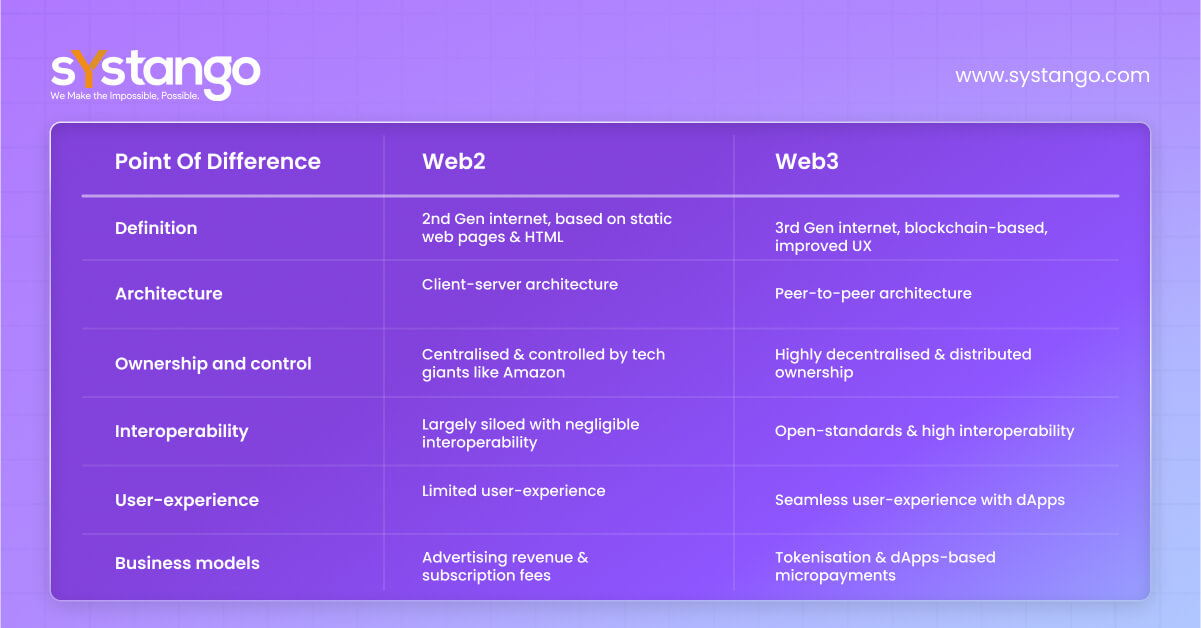Web2 Vs Web3: Emergence Of Decentralisation
Published on 22 Feb 2023

Web2 Vs Web3: Emergence Of Decentralisation
Have you ever wondered how the web has evolved since its invention? Between the period of 1991 and 2004, the internet was mostly a bunch of static pages. It was also known as the read-only web. There was no login or analytics portal. It was mostly like one vast Wikipedia all hyperlinked together. With time internet has evolved a lot, and software like Flash and Java have upgraded the web in terms of its features and functionality. With almost three decades of upgradation, the current version of the web known as Web3 was innovated. It envisions information being smoothly regulated throughout a decentralised platform where the people have secure ownership and their control is distributed.
As per a recent Nasdaq article, most executives of Fortune 500 companies have revealed a constant mandate to develop a Web3 plan in 2023 and invest capital for the same. Web3 is majorly gaining traction because of its build which is based on cutting-edge technologies like blockchain, cryptocurrencies, virtual accessibility, semantic web, IoT, AI, and a lot more. Therefore this web version is called the Read-Write-Own web.
In this article, you will learn about the evolution of web versions, dynamic aspects of Web3, Web2 vs Web3 and details of Web3 architecture. Without further ado, let’s dive into the concept of Web3!
- History and evolution of various web versions
- Overview of Web3
- Components of Web3
- Web2 vs Web3
- What are the Web3 limitations?
- Systango’s Role In Web3 Innovation
History And Evolution Of Various Web Versions

Web1.0
When Berners-Lee was a computer scientist at CERN in 1990, he played a pioneering role in the early development of the Internet. By October of that year, he had authored the three fundamental technologies that formed the foundation of the web, which included the very first webpage editor/browser, WorldWideWeb.app. These three technologies were:
- HTML (HyperText Markup Language), which is the markup or formatting language of the web
- URI or URL (Uniform Resource Identifier or Locator), which is a unique address used to identify each resource on the web
- HTTP (HyperText Transfer Protocol), which allows for the retrieval of linked resources from across the web.
The mid-1990s saw the emergence of web browsers like Netscape Navigator, which marked the beginning of Web 1.0. This was the era of static webpages that were retrieved from servers, which was a far cry from the sophisticated content that we take for granted today. At that time, most internet users were thrilled by features like email and real-time news retrieval. While content creation was still in its early stages, the increasing popularity of online banking and trading provided more opportunities for interactive applications.
Web2.0
Web 2.0 marks a paradigm shift in internet usage, where the drab web pages of Web 1.0 have given way to a more interactive, socially-connected, and user-generated content-driven internet over the past 15 to 20 years. With Web 2.0, user-generated content can now reach millions of people around the world instantly, leading to a surge in this type of content in recent years.
The growth of Web 2.0 has been propelled by key innovations such as mobile internet access, social networks, and the widespread use of powerful mobile devices like iPhones and Android devices. In the second decade of this millennium, these developments have paved the way for popular apps like Airbnb, Facebook, Instagram, TikTok, Twitter, Uber, WhatsApp, and YouTube, among others, that have significantly expanded online interactivity and utility.
The success of these dominant platforms has led to an explosion in revenue growth and made companies like Apple, Amazon, Google, Meta (formerly Facebook), and Netflix some of the world’s largest by market capitalisation (often referred to as FAANG). Furthermore, these applications have also been a catalyst for the gig economy by enabling millions of people to earn income through part-time or full-time driving, home renting, food and grocery delivery, or online sales.
However, Web 2.0 has also caused major disruptions in certain industries, with some failing to adapt to the new web-centric business model, resulting in an existential threat. Retail, entertainment, media, and advertising are among the hardest-hit sectors.
Web3.0
Web 3.0 is the semantic version of the web that intends to power internet content regulation via machine readability. It is an evolution of the internet that combines blockchain technology, decentralised networks, and advanced cryptography to enhance the openness, transparency, and security of the web, building upon the static HTML pages of Web 1.0 and interactive web applications of Web 2.0. A key aspect of Web 3.0 is the use of decentralised applications (dApps) that operate on blockchain networks, providing greater resilience to interference and censorship compared to traditional web applications.
With the help of the preceding sections, you must have got a clear understanding of how the web has evolved over the decades. Let’s move ahead and comprehend the concept of Web3 and how it is different from Web3.0 in the following section.
Overview Of Web3
In simple terms, Web3 technology is an open and decentralised web platform. It was by Gavin Wood, co-founder of Ethereum in 2014. The core notion behind Web3 is to build a decentralised internet by eliminating the centralised Web2 platforms like Facebook and Amazon. Web3 focuses on distributing the control to internet users. Its motive is to reclaim data ownership from all the Web2 giants and give it back to the users via blockchain technology, distributed storage and Self-Sovereign Identity(SSI) in an ecosystem that is driven by the community of Internet users only. In this case, users will have the prime say on who will have access to what sort of data.
Now you must be wondering how this sort of decentralisation is regulated on a global scale. To answer this question, Web3 offers decentralisation with the help of the following features:
- Semantic web
- Artificial intelligence and natural language processing
- 3D graphics
- Semantic metadata connectivity
- Content ubiquity
- Decentralised ledger technology
- Smart contracts
Next, you will learn how the various components of the Web3 ecosystem are articulated in a set hierarchy in the following section.
Components Of Web3
Now talking about the technology constitution, you need to understand that Web3 is not a single layer of the internet ecosystem, but a series of semantic layers that formulate the entire decentralisation of Web3 technology. Come! let’s understand the hierarchy of Web3 layers to comprehend decentralisation in a better manner.

Layer 1
Core layer
First comes the foundational or the core layer of Web3 which constitutes:
- Blockchain protocols
- Cryptocurrencies
- Decentralised storages
- Identity managers
Transactional layer
Then comes the layer which regulates the exchange and remittance activities and offers the following
- Exchanges
- Custodians
- Payments
- Wallets
Layer 2
Painkillers
Now, you need to understand that there are some loopholes from layer 1 of the Web3 ecosystem like interoperability issues, storage issues, and lack of a full-fledged payment automation system. To address these points, painkillers in layer 2 act as the solution.
- Sidechain scaling solutions
- Blockchain development platform
- Security audit platform
- Parachains
- Blockchain monitors
- Blockchain rating and review platforms
Vitamins
Vitamins encompass a range of tools and utilities that facilitate the smooth integration of Web3 applications. These include
- Bionic
- OpenZeppelin
- Mirror.XYZ
- Snapshot
- Chain Analytics
- dYdX
Platforms for services
In contrast to the preceding layers which rely more on automation and software development, services require manual efforts. Platforms for services comprise the following:
- Smart contract ecosystems like Mattereum
- Crypto exchange platforms like Binance
- Cryptocurrency for international money exchange like Electroneum
- Federally licensed crypto banks like Anchorage
- An institutional trading platform like Talos
Layer 3
NFTs
NFTs have emerged as a prominent use case of blockchain technology, and several NFT marketplaces are flourishing. This layer encompasses:
- User-portal for NFT marketplace like NFTinger
- Anchor NFT staking
- NFT service providers
- NFT marketplaces like OpenSea
Metaverse platforms
- Decentraland
- Spatial
- Metavesal
Web3 communication protocols
- Messaging protocol like XMTP
- Notification protocols like Ethereum Push Notification Service(EPNS)
- Decentralised messaging networks like Matrix
Web3 gaming platforms
- Blockchain gaming platforms like Gala Games
- NFT-based gaming platforms like Axie Infinity
Social media
The establishment of a decentralised social network may take time due to the growing concerns surrounding data breaches, malware, security issues, and related cybercrimes. Web3 social media encompasses decentralised social networking applications such as:
- Minds
- Mastodon
- Peertube
- Pixelfed
Furthermore, to align with Web3 infrastructure and maintain user privacy, current social media platforms must be integrated accordingly. As for the upcoming decentralised social network, it is expected to be integrated with the persistent Metaverse and may be embedded in social networking. This would address issues such as data leakage, malware, security and cyber crimes.
Web2 Vs Web3
Take a look at the comparison table given below for your clear comprehension of Web2 vs Web3.

Before you invest yourself in exploring or developing Web3 technology, you must understand its limitations also. This will help you leverage Web3 technology to its full potential.
What Are The Web3 Limitations?
Currently, Web3 faces certain limitations, such as:
- Scalability
Reduced scalability due to the decentralised nature of transactions. Any modifications to the state, such as making a payment, require processing by a node and dissemination throughout the network, resulting in slower transaction times. - UX
Utilising Web3 applications may require additional software, education, and steps, which can hinder user adoption. - Accessibility
Due to inadequate integration with modern web browsers, Web3 may not be easily accessible to most users. - Cost
The high cost associated with blockchain usage often necessitates that only small segments of code are put on the blockchain, particularly for successful dApps.
Now that you have a fair picture of Web3 technology and the comparative analysis in terms of Web2 vs Web3, it’s time to look at the following section where you comprehend what Systango offers as a Web3 development company.
How Systango Can Help You?
- Web3-based ideation & design to development and execution
- Expertise in next-gen web3 game development via Unity tool
- Web3 developers with expertise in custom dApp development
Systango’s Role In Web3 Innovation
We as a Web3 and blockchain development company have assisted numerous businesses in capitalising on blockchain technology by developing commercially feasible blockchain solutions and incentivising all parties involved. Our proficient blockchain developers possess expertise in constructing various blockchain-based applications such as NFTs, DApps, DeFi, Metaverse, blockchain game development, DAOs, Exchanges, wallet integrations, custodial wallets, smart contracts, marketplaces, stablecoins, and beyond.
Systango as the pioneer in the blockchain revolution has enabled startups and enterprises to seamlessly integrate Web3 technology. Our team possesses a unique set of Web3 development skills, detailed knowledge of Web2 Vs Web3 and technical expertise tailored to your individual requirements, strategic objectives, and infrastructure. With our proficiency across major blockchain platforms such as Ethereum, Flow, Binance Smart Chain, Solana, Tron, Polygon, and our experience serving diverse industries, we offer a wealth of knowledge and a track record of successful production implementations for businesses worldwide.
Connect with us for expert Web3 development services and build your dream Web3 integrated platforms based on cutting-edge technologies seamlessly!
Related posts
Blockchain
News
NFT
Software Development
Technology
Web 3
How Systango Pioneered USA's 1st NFT Ticketing Marketplace for Veraticket?
01 Feb 2024
Blockchain
News
Technology
Web 3
DeFi Hype Explained: A Deep Dive into the Booming World of Decentralized Finance
05 Jan 2024
Let’s talk, no strings attached.
